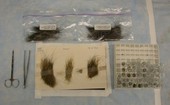IGERT Story
Hormones, life history, and hair
Description
Differences in male life history patterns among primates represent a complex of tradeoffs between the costs of immediate reproduction and future reproductive output. Therefore, it is important to understand reproductive costs in order to model the evolution of life history strategies in primates and ultimately ourselves. One way in which to assess reproductive costs is by examining the physiological basis and correlates of life history stages. Hormones are essential for the expression and regulation reproductive processes and behaviors. These same hormones can also have negative health effects if maintained at chronically high levels, thus impacting fitness. Hormone levels are therefore a useful measure of reproductive costs, and are important for understanding life history strategies. Ultimately, socioecological processes drive the evolution of life history strategies, but it is hormone-behavior interactions that are the mechanisms underlying life history evolution.
Studies of hormone-life history and behavior interactions often a take a cross-sectional population level approach or focus on stable behavioral patterns (i.e. personality/temperament). In such research designs, measures of hormone levels that reflect an averaged picture of endocrine activity are required. Hormones in primates are typically determined from blood, feces, or urine. These substrates archive hormone levels which only reflect short periods of endocrine activity. Hormone levels in these substrates are also acutely sensitive to transient fluctuations in endocrine function. Therefore, in order to arrive at an averaged (or basal) picture of endocrine activity, multiple samples must be collected for each individual. Such repeat collection can be logistically and financially challenging, especially in the field. Hair is known to archive a number of steroid hormones relevant to the study of behavior and life history. Hormone levels in hair are unique in that they are accumulated over the growth period of the hair, and therefore reflect circulating hormone levels averaged over a period of weeks or months. Consequently a single hair sample can provide a picture of basal hormone levels that would take weeks or months to collect using blood or feces.
Hair hormone analysis has many exciting advantages and potential, but it is important to properly validate the use of such a relatively novel technique for each species and hormone that is investigated. Currently I am working on validating the technique in a taxonomically diverse sample of wild and captive primates. My data suggest that cortisol remains well preserved within the hair shaft, and tracks developmental and biological differences in endocrine function. Validation of testosterone determination in the hair of primates remains ongoing and preliminary results look promising. Typically, I use enzyme immunosorbent assay techniques to quantify steroids in hair, but my research will take me back to the Smithsonian’s Conservation Biology Institute this spring, where I will be working with radio immunosorbent assay techniques as well. Ultimately, I will use the validated procedures in order to investigate hormone-life history relationships in a large multi taxon sample of Papio baboons.






